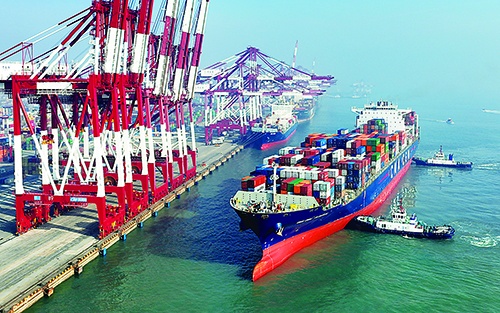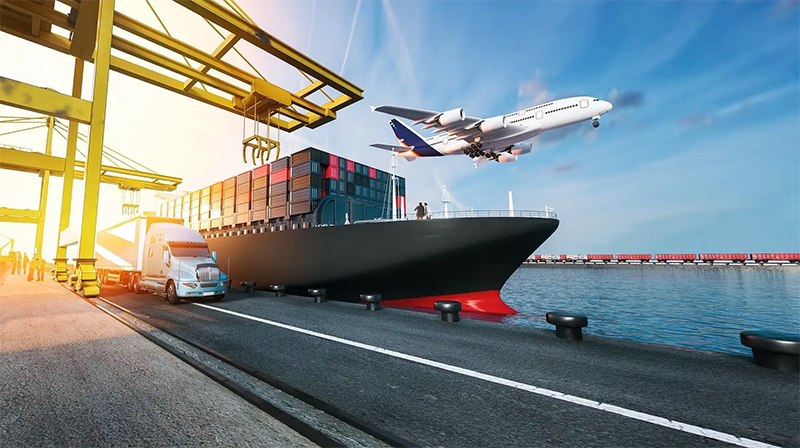In the era of globalization, international trade has become a driving force for economic growth, with transportation serving as a critical pillar underpinning its success. International trade terms define the allocation of responsibilities, costs, and risks between buyers and sellers in goods transportation and related processes, while diverse transportation modes offer enterprises tailored solutions. This article provides an in-depth analysis of common international trade terms and transportation methods—including sea, air, and express shipping—to equip enterprises with a comprehensive guide for navigating global trade.

I. Common International Trade Terms
(1) Port of Shipment Delivery Terms
FOB (Free on Board)
- Definition: The seller fulfills delivery by loading goods onto the buyer’s nominated vessel at the specified port of shipment or by acquiring goods already so loaded. Risk of loss or damage transfers to the buyer when goods cross the ship’s rail.
- Key Responsibilities:
- Seller: Load goods onto the vessel within the contract period and notify the buyer.
- Buyer: Arrange vessel booking and bear post-loading risks.
- Applicability: Sea or inland waterway transport.
CFR (Cost and Freight)
- Definition: The seller delivers goods on board the vessel or acquires goods already delivered, with risk transferring to the buyer at the time of loading.
- Key Responsibilities:
- Seller: Cover freight costs to the destination port but not insurance.
- Buyer: Assume post-loading risks and insurance arrangements.
- Applicability: Sea or inland waterway transport.
CIF (Cost, Insurance, and Freight)
- Definition: The seller completes delivery when goods pass over the ship’s rail at the port of shipment, requiring export customs clearance.
- Key Responsibilities:
- Seller: Charter vessels, pay freight/insurance, and handle export formalities.
- Buyer: Assume post-loading risks despite seller’s upfront costs.
- Applicability: Sea or inland waterway transport, ideal for comprehensive risk coverage.
(2) Destination Delivery Terms
DAP (Delivered at Place)
- Definition: The seller delivers goods at the nominated destination, ready for unloading but without completing卸货 (unloading).
- Key Responsibilities: Seller bears all risks/costs to the destination (excluding import customs fees).
- Applicability: All transport modes.
DDP (Delivered Duty Paid)
- Definition: The seller completes delivery at the destination after importing customs clearance, with goods remaining unloaded from the transport vehicle.
- Key Responsibilities: Seller assumes full responsibility for transportation, customs, and fees— the highest obligation under Incoterms.
- Applicability: All transport modes.
II. Sea Transportation
(1) Key Characteristics
- Advantages: High capacity, low cost, suitable for large-volume, low-timeliness cargo (e.g., bulk raw materials, machinery).
- Challenges: Slow transit speed, vulnerability to weather disruptions (e.g., storms causing delays).
(2) Operational Process
- Booking: Shippers apply to shipping lines/agents, providing cargo details (name, quantity, weight, ports).
- Loading: Goods are loaded at the port of shipment, with proper stowage to ensure safety.
- Ocean Voyage: Vessels follow predefined routes; carriers manage in-transit cargo care.
- Unloading: Costs determined by trade terms (e.g., CFR vs. CIF).
- Delivery: Post-unloading customs clearance and handover to consignees.
(3) Critical Documents
- Bill of Lading (B/L): Serves as a cargo receipt, title document, and evidence of the contract of carriage.
- Shipping Order (S/O): Authorizes customs clearance and cargo loading.
- Manifest: Details all cargo on board for customs and statistical purposes.
III. Air Transportation
(1) Key Characteristics
- Advantages: Speed, safety, ideal for high-value, time-sensitive goods (e.g., electronics, pharmaceuticals, perishables).
- Challenges: High cost, limited capacity for large volumes.
(2) Operational Process
- Consignment: Shipper delivers goods to the airport terminal with air waybill and customs documents.
- Forwarder Coordination: Agents book space with airlines and manage logistics.
- Customs Clearance: Pre-shipment declaration and inspection.
- Flight Transportation: Cargo is loaded into aircraft holds and transported to the destination.
- Destination Clearance: Consignee settles duties and collects goods post-customs release.
(3) Critical Documents
- Air Waybill (AWB): Evidences the contract of carriage but is non-negotiable (unlike B/L).
- Commercial Invoice: Details goods’ value for customs and payment.
- Packing List: Specifies packaging, weights, and quantities for logistics coordination.
IV. Express Delivery
(1) Key Characteristics
- Advantages: Door-to-door service, speed, and convenience for small-batch, high-value items (e.g., documents, samples).
- Challenges: Premium costs, unsuitable for large or cost-sensitive shipments.
(2) Operational Process
- Pickup: Courier collects goods, verifies compliance, and issues waybills.
- Transport: Combines road, air, or rail based on destination and urgency.
- Transshipment: Cargo is sorted at hubs for onward delivery.
- Delivery: Recipient signing confirms successful handover.
(3) Critical Documents
- Express Waybill: Records shipment details and serves as proof of contract.
- Commercial Invoice: Facilitates customs valuation and duty calculation.
V. Strategic Selection of Transportation Modes and Terms
(1) Transportation Mode Criteria
- Cargo Characteristics:
- Sea: Heavy/bulky goods (e.g., machinery, grains) with flexible timelines.
- Air/Express: High-value, urgent items (e.g., tech products, medical supplies).
- Cost vs. Speed: Balance freight costs against delivery deadlines (e.g., sea for cost savings, air for time-critical orders).
(2) Trade Term Selection
- Risk Allocation:
- FOB: Shifts risk to buyers post-loading, suitable for sellers seeking minimal post-shipment liability.
- CIF: Sellers manage insurance/freight, ideal for buyers prioritizing full-service logistics.
- Market Practices: Align with regional norms (e.g., CIF common in Asia-Europe trade; FOB in U.S. imports).

VI. Conclusion
International transportation modes and trade terms are integral to global commerce, requiring strategic alignment with business objectives. Enterprises must deeply understand the nuances of each transport method and Incoterm to mitigate risks, optimize costs, and ensure compliance. By tailoring choices to cargo needs, market dynamics, and stakeholder expectations, businesses can streamline trade operations, foster trust with global partners, and achieve sustainable growth in the competitive international marketplace.
Media Contact
Company Name: Zhejiang Rambo Intelligent Technology Co., Ltd.
Email: Send Email
Phone: +86-16605760098
Country: China
Website: https://www.zripump.com/
